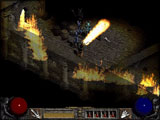 In our First
Impressions of Diablo II, we listed a few of the summer disappointments we'd experienced
at GamesFirst! Namely, we were impatient for Diablo II's release, and when it finally hit
the shelves, we were impatient to finish the game. At the time, we liked what we
saw, had a few reservations, and were hoping to experience the same unbridled, ferocious
joy we felt when we first banished Diablo to the Soulstone in the first game ... only we
wanted even more ferocious joy this time. At GamesFirst!, we pride ourselves on a
commitment to consistency, but we might have to swallow a little pride on this one.
While we stand by our First Impressions--based upon Acts One and Two--we were
disappointed to discover that what we originally reported as minor anomalies and
annoyances turned out to be frustrating bugbears that diminished the potential excellences
of the game. In our First
Impressions of Diablo II, we listed a few of the summer disappointments we'd experienced
at GamesFirst! Namely, we were impatient for Diablo II's release, and when it finally hit
the shelves, we were impatient to finish the game. At the time, we liked what we
saw, had a few reservations, and were hoping to experience the same unbridled, ferocious
joy we felt when we first banished Diablo to the Soulstone in the first game ... only we
wanted even more ferocious joy this time. At GamesFirst!, we pride ourselves on a
commitment to consistency, but we might have to swallow a little pride on this one.
While we stand by our First Impressions--based upon Acts One and Two--we were
disappointed to discover that what we originally reported as minor anomalies and
annoyances turned out to be frustrating bugbears that diminished the potential excellences
of the game.
As we reported, nothing we continue to say about the game really is going to
make any difference. As of this writing, it is the fastest selling pc game of all
time. Boasting 1.5 million pre-sales, Diablo II has actually sold a million units.
Of course, at this point, Blizzard could sell a million empty boxes with their name
on them, such is their well-earned reputation.
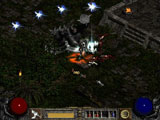 Basically, the first act is both training ground for the few
that didn’t play the original and an effective warm-up for Diablo veterans. It's apparent that Act One was the first segment
built for Diablo II because graphics and gameplay closely resemble Diablo. Subtle changes
become evident in the remaining Acts where there are more items to gather and swap, and
the enemies are more numerous and harder to beat. How successfully players
obliterate some of the awesome new enemies (check out those Unravelers, Fetish Shamans and
Wraiths!) takes a little more strategy in selecting which skills will best deal with them.
The quests seem a little less linear as well, a feature that is both pleasing and
maddening, especially when players desire to retry the same quest. Be forewarned:
saving and quitting after clearing out a level results in a repopulated map upon return.
The upside of this feature is that players can quickly gain experience and booty in
a familiar location. On the downside, players seeking to activate waypoints or
simply pass through a map must slog through heaps of foes. Basically, the first act is both training ground for the few
that didn’t play the original and an effective warm-up for Diablo veterans. It's apparent that Act One was the first segment
built for Diablo II because graphics and gameplay closely resemble Diablo. Subtle changes
become evident in the remaining Acts where there are more items to gather and swap, and
the enemies are more numerous and harder to beat. How successfully players
obliterate some of the awesome new enemies (check out those Unravelers, Fetish Shamans and
Wraiths!) takes a little more strategy in selecting which skills will best deal with them.
The quests seem a little less linear as well, a feature that is both pleasing and
maddening, especially when players desire to retry the same quest. Be forewarned:
saving and quitting after clearing out a level results in a repopulated map upon return.
The upside of this feature is that players can quickly gain experience and booty in
a familiar location. On the downside, players seeking to activate waypoints or
simply pass through a map must slog through heaps of foes.
The game world is huge, and so is the install. Single-player-only is 650 mb, multiplayer &
single player install (without cutscenes) is 950 mb and full install is 1.55 gig. While it is possible to play single player
exclusively, we thought the real fun (and challenge) would come from playing cooperatively
with others. Diablo II is designed to
increase in difficulty depending on how many players are in that game; a game with two
people playing is a cakewalk compared to a game with eight.
With the increased risk of playing with multiple people comes an increase in
experience and loot.
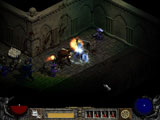 In Diablo II, characters can run, so the game is much faster. Characters are
also more customizable, the world is bigger, there are new character classes, and playing
online now includes all the quests and conversations of the single-player game. And speaking of playing online, Diablo II offers
two choices when using Battle.net. Regular
Battle.net offers increased security for online players by storing your character on
it’s servers and Open Battle.net allows
gamers to use single player characters or those made by other multiplayer games such as
TCP/IP. In Diablo II, characters can run, so the game is much faster. Characters are
also more customizable, the world is bigger, there are new character classes, and playing
online now includes all the quests and conversations of the single-player game. And speaking of playing online, Diablo II offers
two choices when using Battle.net. Regular
Battle.net offers increased security for online players by storing your character on
it’s servers and Open Battle.net allows
gamers to use single player characters or those made by other multiplayer games such as
TCP/IP.
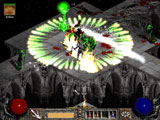 In the original Diablo, everybody played The Wanderer. In
Diablo II, however, there are five character classes to choose from: Barbarian,
Necromancer, Amazon, Paladin, or Sorceress. Each
class has the typical AD&D RPG attributes. Spellcasters like the Sorceress and
Necromancer have a relatively weak physical attack and less health, but have their
mystical powers to do battle with. And the
Barbarian, Amazon, and Paladin are very much of the in-your-face-hack-and-slash variety. Each character has access to special abilities
defined by a redesigned skill tree that replaces spell books in the original. In the original Diablo, everybody played The Wanderer. In
Diablo II, however, there are five character classes to choose from: Barbarian,
Necromancer, Amazon, Paladin, or Sorceress. Each
class has the typical AD&D RPG attributes. Spellcasters like the Sorceress and
Necromancer have a relatively weak physical attack and less health, but have their
mystical powers to do battle with. And the
Barbarian, Amazon, and Paladin are very much of the in-your-face-hack-and-slash variety. Each character has access to special abilities
defined by a redesigned skill tree that replaces spell books in the original.
While spell effects
and the occasional architectural detail are beautifully rendered, the graphics are
disappointing overall. Like the original, Diablo II is limited to a resolution of
640x480. We expected improvements in this feature and an increase in environmental
detail. Act One, for example, looks very much like Diablo's Tristram. The
Palace in Lut Gholein, on the other hand, was a remarkably detailed feature in Act Two.
This incremental improvement in graphics led us to anticipate even greater and more
refined visuals in the two remaining acts. Sadly, we must report that our
anticipation was hasty. There is no significant improvement in Diablo II's graphics
despite today's video card capabilities. In other words, Diablo II looks a lot like
Diablo (a game four years older), and we were expecting more especially since players have
the option of implementing 3D accelerators. Regrettably, Diablo II's 3D capabilities
are limited to a slight increase in spell effects and depth perspective.
In contrast to the
gameplay graphics, the excellent cinematics between acts are all high quality
and almost as long as the opening clip. Digital
moviemaking should aspire to the quality of these pieces. Given the often repetitive
gameplay of Diablo II--we are, after all, talking about a classic hack-and-slash--the
cutscenes remind players of the richly textured and complex narrative that organizes and
drives the action. So even though the gameplay and graphics of Diablo II were a
letdown, we were consoled by the surprises and twists revealed in the movie concluding the
game. While we're not in the business of dishing the big scoop, let's just say that
no one here at GamesFirst! will be too shocked at the prospect of further adventures in
the world once under Diablo's thrall.
Another successful
element of Diablo II is the opportunity to interact with throngs of different Non-Player
Characters (NPCs). All NPC text is written
well enough to give each a distinctive personality and the voice acting is quite good. During friendly exchanges with NPCs in town,
players can barter surplus items or buy new goods with hard-won gold. Players can also
stow excess baggage, loot, and rare items in their personal Stash. This Stash is one
our favorite additions to the game because it allows players to store precious items and
piles of filthy lucre securely and permanently. No more throwing gold on the ground!
As suggested above,
not all NPCs are buddies. Indeed, most are not. Run of the mill monsters
don’t really talk, but they do groan, grunt, and yelp as players and their parties
pound them into oblivion. The bosses,
however, are always easy to identify because they let fly with explosive rants when
disturbed from their evil-doings. They're
typically rendered in some disgusting pus green or throbbing puse color, too, so players
can easily tell them apart from their rank and file counterparts. As with
other RPG-style games, the farther you get, the more difficult gameplay gets—and the
monstrous behemoths that challenge players at the end of each act become more and more
resilient and get considerably harder to slay as the hunt for Diablo progresses.
In addition to the
NPCs, Diablo II introduces an intermediary class of character that functions as a playing
character and NPC--Mercenaries. These hired-hands and their services are available
for purchase in the first three Acts. Not all mercenaries are alike, though. Some
fight with ranged weapons while others engage directly in hand-to-hand combat. Some even
possess magical resistances. Unfortunately, players are unable to control these
mercenaries directly. The pathing AI often moves mercenaries into contact with enemy
NPCs when it's not strategically advantageous. Also, mercenaries tend to block
chokepoints, often preventing hasty retreat or aggressive attack. Higher skilled
mercenaries cost more money, but seem to play at no better than half their level rating.
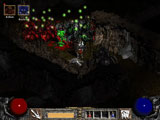 All reviewers agree that Diablo
II's music is chillingly atmospheric and evokes the subtle textures and tones that
distinguish each act. In fact, the score is so popular, that Blizzard is
periodically releasing MP3 files of the tracks for free download. The score is very
reminiscent of Diablo's—in an effectively nostalgic touch, for example, when you
revisit Tristram, you’ll find the music is duplicated from the original. Audio clues and moods change frequently depending
on where players are and what they're doing. This musical variation goes a long way
to keep the score from becoming stagnant and is useful in identifying important moments in
the game. When the music becomes
cinematically tense ala "The Good, the Bad, and the Ugly" or
"Psycho," players know that something big is about to happen. All reviewers agree that Diablo
II's music is chillingly atmospheric and evokes the subtle textures and tones that
distinguish each act. In fact, the score is so popular, that Blizzard is
periodically releasing MP3 files of the tracks for free download. The score is very
reminiscent of Diablo's—in an effectively nostalgic touch, for example, when you
revisit Tristram, you’ll find the music is duplicated from the original. Audio clues and moods change frequently depending
on where players are and what they're doing. This musical variation goes a long way
to keep the score from becoming stagnant and is useful in identifying important moments in
the game. When the music becomes
cinematically tense ala "The Good, the Bad, and the Ugly" or
"Psycho," players know that something big is about to happen.
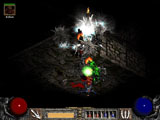 Blizzard has developed several improvements for Diablo II while
preserving the intuitive interface that made Diablo such a standout in 1996. In
contrast to these welcome changes, however, Blizzard retained graphics and hack-and-slash
gameplay that, once innovative, are now dated. Also troubling is the fact that
Diablo II has proven to be the least stable game Blizzard has released.
Historically, Blizzard has always designed and released the most reliable games in
the business capable of running on low-end machines. Despite the million copies of
Diablo II that have been purchased, as of this writing, Battle.net servers continue to be
unreliable, further undercutting players' expectations. In the end, Diablo II is fun
to play, continues to be updated and improved with patches, and we expect Battle.net
issues to be resolved eventually. Even so, Diablo II is an evolutionary, not a
revolutionary, game unlike its predecessor. Here at GamesFirst!, we'd like to claim
that Diablo II is just as compelling, just as addictive, as Diablo was. But it's
summer. And that can only mean one thing: we're still disappointed. Diablo II
is a good game that failed to fulfill our expectations for a great game.
Blizzard has developed several improvements for Diablo II while
preserving the intuitive interface that made Diablo such a standout in 1996. In
contrast to these welcome changes, however, Blizzard retained graphics and hack-and-slash
gameplay that, once innovative, are now dated. Also troubling is the fact that
Diablo II has proven to be the least stable game Blizzard has released.
Historically, Blizzard has always designed and released the most reliable games in
the business capable of running on low-end machines. Despite the million copies of
Diablo II that have been purchased, as of this writing, Battle.net servers continue to be
unreliable, further undercutting players' expectations. In the end, Diablo II is fun
to play, continues to be updated and improved with patches, and we expect Battle.net
issues to be resolved eventually. Even so, Diablo II is an evolutionary, not a
revolutionary, game unlike its predecessor. Here at GamesFirst!, we'd like to claim
that Diablo II is just as compelling, just as addictive, as Diablo was. But it's
summer. And that can only mean one thing: we're still disappointed. Diablo II
is a good game that failed to fulfill our expectations for a great game.
We're goin' fishin'.
--Greg Matthews
& Al Wildey |
